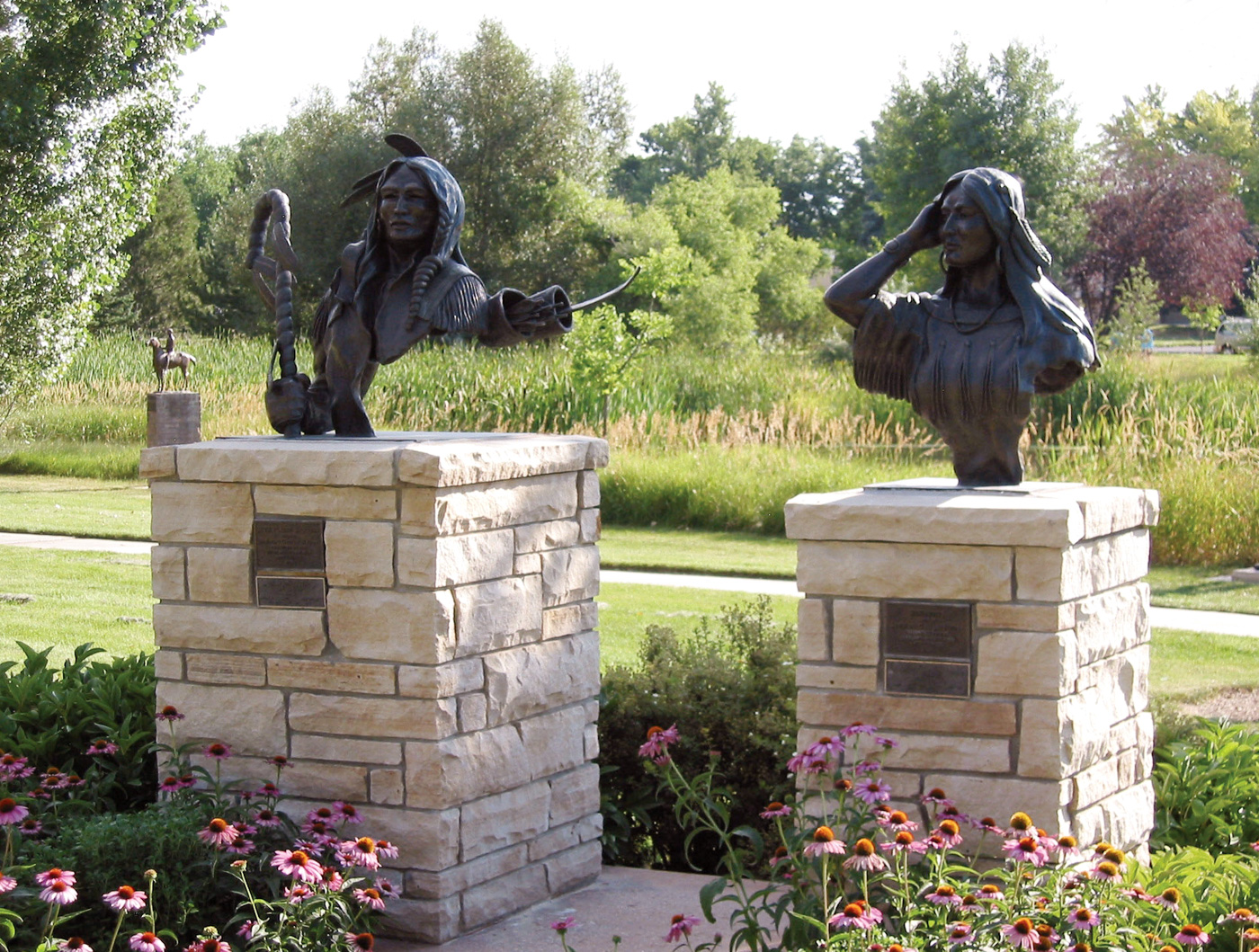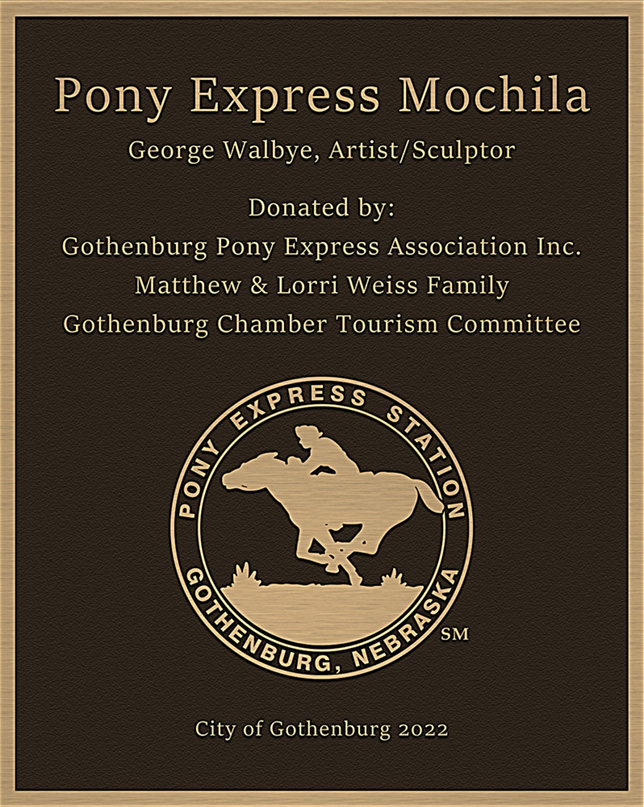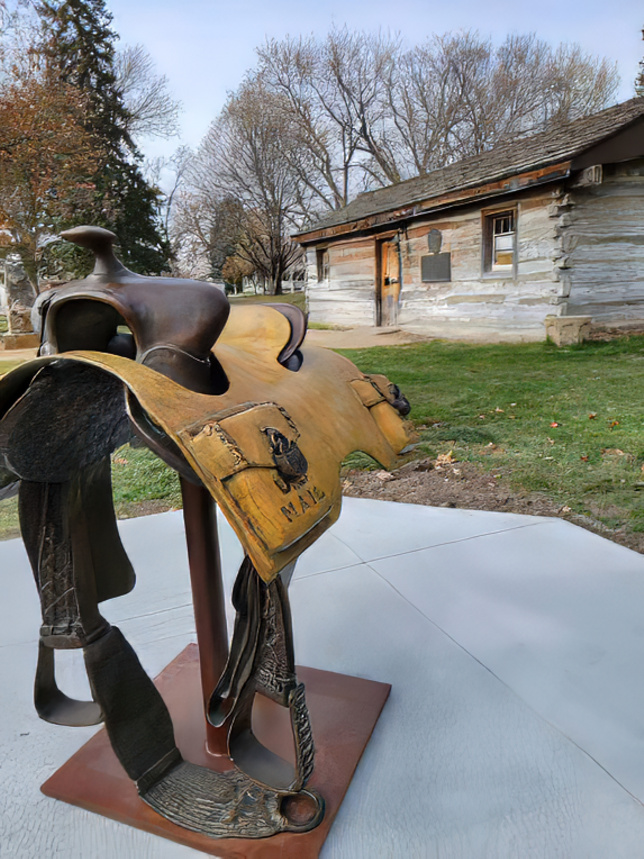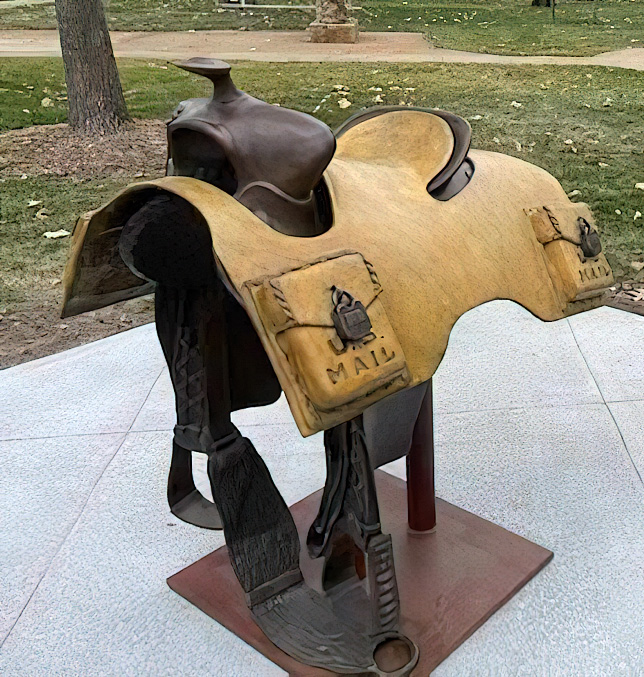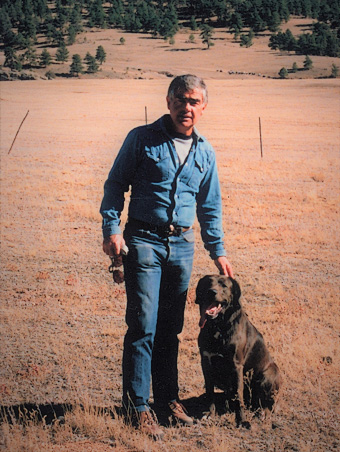
George Walbye is a sculptor whose work authentically reflects his life in the American West. A genuinely self-taught artist, he has drawn deeply on memories of a way of life that is gradually disappearing from the American landscape.
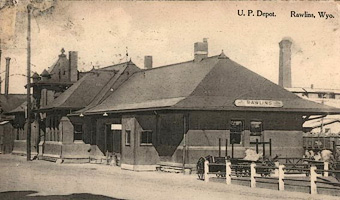
As a child of the Depression growing up in Rawlins, Wyoming, George had a childhood of almost unimaginable freedom.
Rawlins was a rough town on the Union Pacific railroad line filled with cowboys, trappers, railroad workers, gamblers, and men who’d come West to escape their past in the East.
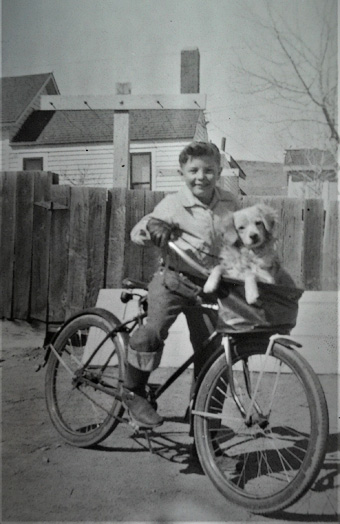
As a young boy, he rode his bike to wherever the action was. He sold newspapers around town and to the soldiers on the troop trains that lumbered through Rawlins. He saved his money and by age twelve bought his first horse, Buck, for $50.00. He and Buck covered many miles together.
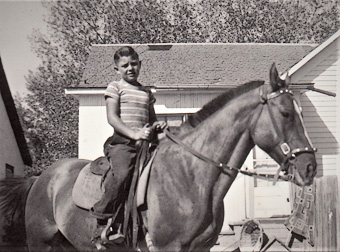
George has said that some of his best memories of those days were “riding a good horse through good country” and “the smell of sagebrush after a rain.”
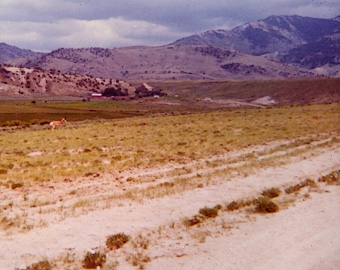
George’s grandfather, A.A. Harper, had been a homesteader in the 1890’s at Whiskey Gap, Wyoming and as George grew a little older, he spent summers working on ranches in that area. During the scant moments between chores he’d often pull out his pocket knife and whittle a stray piece of sage wood. His grandfather had created wood carvings during the long Wyoming winters and young George also had a knack for carving.
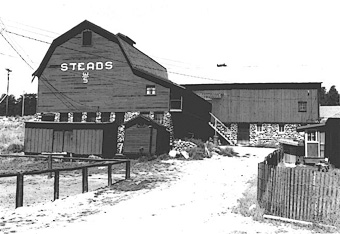
In his mid-teens, he got a summer job as a wrangler at Steads Ranch in Moraine Park, Colorado.
As the season was winding down and he was preparing to return to high school in Rawlins, he received a penny postcard from his mother. In the postcard she hoped he’d had a good time at the ranch and added, “P.S. We moved to Loveland, Colorado.”
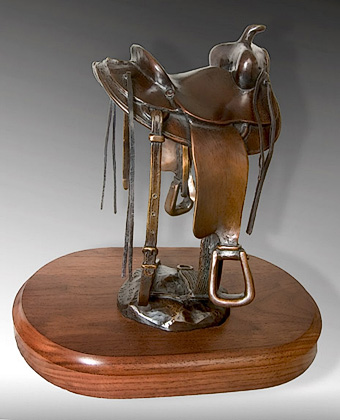
George got a ride to Loveland and entered his new life there with $300.00 and a Powder River saddle over his shoulder. Loveland, at first, seemed awfully tame to a free-wheeling Wyoming cowboy. However, George soon came to see its merits.
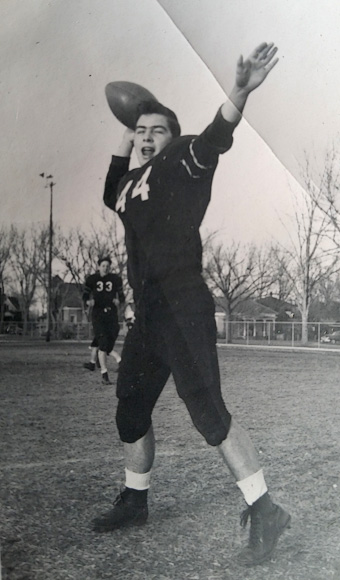
He could participate in sports at a more competitive level. He was the Loveland High School quarterback during football season and a pole vaulter in track season. As a basketball player, he was “All Conference” and third in scoring in the conference in 1949.
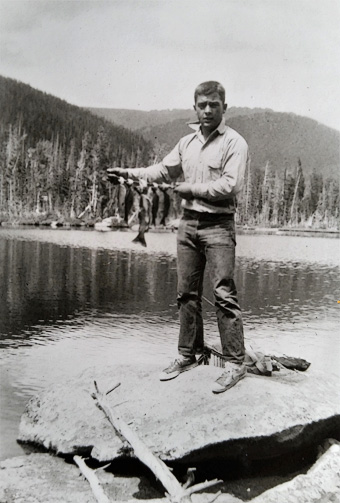
Loveland’s proximity to the Rocky Mountains gave George ample opportunity to hunt and fish as he had in Wyoming. Fishing the high lakes in Rocky Mountain National Park was a particular joy.
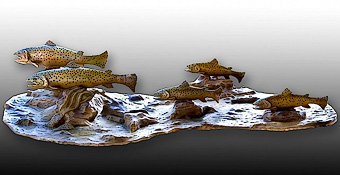
He embraced the strenuous hikes into those icy, clear lakes and often would fish all night long. Sometimes he’d find a bit of pine, pull out his pocket knife and whittle an animal or human figure. The wild natural surroundings were always an inspiration and a joy.
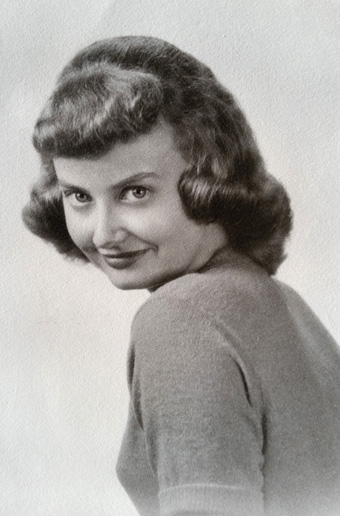
Loveland had another advantage that Rawlins could never match: a pretty high school cheerleader named Phyllis Garrett.
Phyllis was whip-smart and independent. She loved movies, books, culture of all kinds. A cowboy from Wyoming didn’t seem the logical choice for Phyllis, but she was never one to accept the expected. “When Phyllis married me she changed my life,” George has said. During their fifty-seven years of marriage they changed each other and the fortunes of Loveland itself.
George taught physical education and coached freshman football at Loveland High School. As his family grew, he became a car salesman at the Ford dealership owned by Phyllis’ father. George was a natural salesman and thrived in that competitive arena. Fate, however, was about to deal him an exciting new hand.
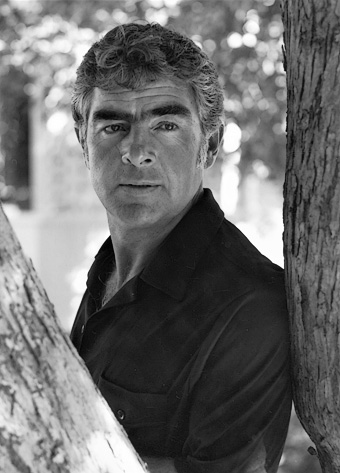
In the late 1960’s, George’s brother-in-law introduced him to a sculptor named Wolfgang Pogzeba. Pogzeba showed George the basics of creating a sculpture using the “lost wax” technique. George was immediately interested and began experimenting by whittling away at home-made blocks of wax. He soon had a few early works in wax that needed to be transformed into bronze. At the time, there was a single industrial foundry in Loveland owned by Bob Zimmerman. After some negotiations, Zimmerman was convinced to make the molds and pour the bronzes. George Walbye was the first artist to have a sculpture cast at what would become Art Castings of Colorado.
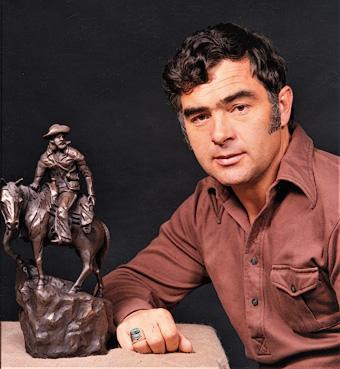
Although he had several sculptures, George had a few lessons to learn. A memorable incident happened in 1972 when George brought his piece “Today’s Journey” to a gallery owner in Santa Fe.
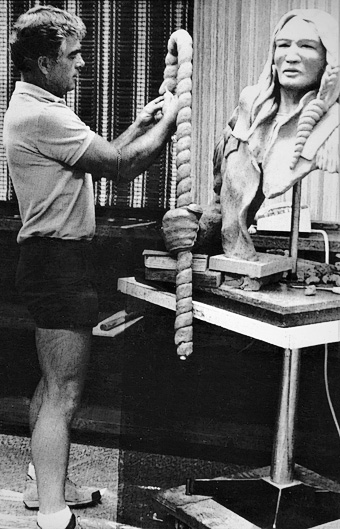
The man was surprised to learn the piece had been whittled out of a single, solid block of wax. George was sent to the studio of a sculptor who introduced him to the concept of using an armature and packing on wax or clay. Sculpting was a matter of addition, not subtraction. Upon returning to Loveland, he made his first armatures from sticks found in the yard and then built them up with softened wax to obtain the desired image. As he created more works and began to sell them, it became clear that the cowboy from Rawlins was truly an artist. His love of the American West, its people, wildlife, and geography became the enduring theme of his work.
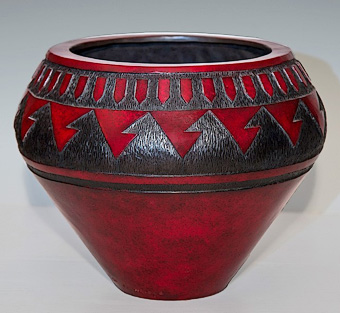
Over six decades George has produced hundreds of sculptures but has become particularly known for his bronze pots and lidded bowls.
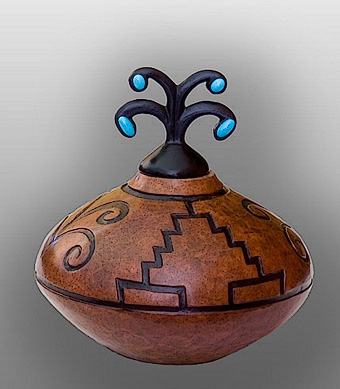
He often incorporates elements such as turquoise and authentic arrowheads in his pieces. His sculptures range from five inches to life size. His work has been exhibited in top galleries and shows throughout the United States.
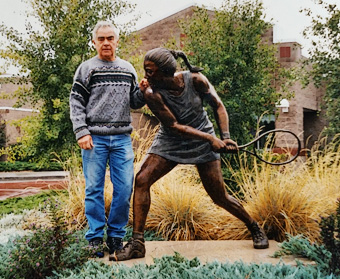
He has sculpture in private and corporate collections in Europe, Canada, and the United States. His work was included in the “Living Arts: A Colorado Sampler” exhibition at the Kennedy Center in Washington, D.C. Life size installations such as “DR’s Saddle” and “Tennis Champion” can be found in Colorado, Wyoming, Nebraska, Arizona, and Texas.
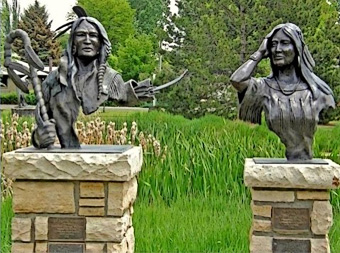
George is especially proud to be one of the group of five artists who envisioned and brought to realization the first Sculpture in the Park show in 1984. He is one of only five artists who has been in every show since its inception.
Loveland’s Benson Sculpture Park became a reality in 1985 and George’s piece, “High Plains Warrior/Wind Song” was the first sculpture to be installed.
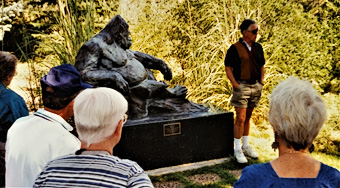
He has worked on and with the High Plains Arts Council from its founding, and serves as an occasional tour guide through Benson Sculpture Park. He has a unique perspective on the artists and history of the park.
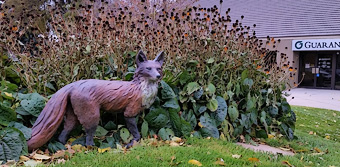
George and his wife, Phyllis, helped influence the enactment of the “Art in Public Places” ordinance which earmarks 1% of all major capital budgets for the purchase of art for the public.
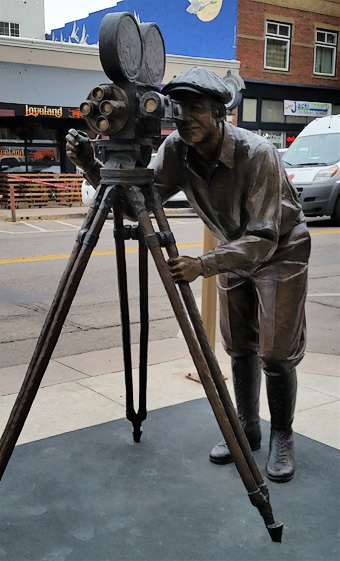
Loveland was the first city in Colorado to take this bold step. In her capacity as arts editor at Loveland’s newspaper, The Reporter Herald, Phyllis used her platform to convince any sceptics about the value of public art. Indeed, Loveland’s quality of life and commerce has benefitted. Loveland has been named one of the best art destinations in the United States. The yearly Sculpture in the Park show attracts thousands of art lovers and collectors. George and Phyllis always felt deeply grateful for the opportunities that Loveland afforded them. They worked hard to make a difference. In 2010, George and his children dedicated a sculpture by Pat Kennedy, “Persistence of Vision” to Phyllis’ memory. It is installed near the entrance of Loveland’s Rialto Theatre.
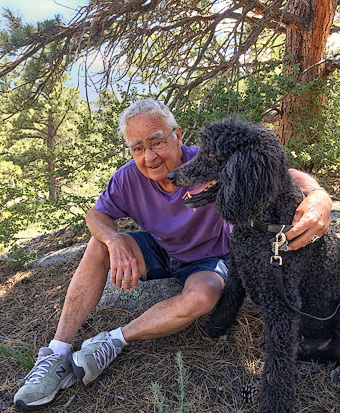
Now in his later years, George’s love of the West is as robust as when he was a boy. He continues to sculpt with enthusiasm and vibrancy, thankful for his life in art.
“Saddling up” for the Pony Express!
Gothenburg, Nebraska – An original Pony Express Station located within a picturesque city arboretum has been welcoming history enthusiasts from all around the world for more than 90 years. Located just a couple of minutes off I-80, an estimated 40,000-50,000 people visit the historical building/museum each year. Now they’ll have one more reason to make the journey – a unique Pony Express bronze statue.
“The past few years, our non-profit organization had been searching for an artist who’d be able to create a truly unique, one-of-a-kind bronze statue for us” said Matt Weiss, president of the Gothenburg Pony Express Association. “Last fall, we finally found that special someone, a well-known bronze sculptor from Loveland, Colorado, George Walbye.”
Walbye is an artist whose work authentically reflects life in the American West. He has sculptures in private and corporate collections in Europe, Canada and throughout the United States. He’s one of the original group of artists who envisioned and brought together the first "Sculpture in the Park" show at the celebrated Benson Sculpture Park in Loveland, Colorado. His original bronze artwork piece “High Plains Warrior/Wind Song” was the first sculpture in 1985 to be installed there. His creative talent, experience and knowledge of the American West was exactly what they had been looking for in an artist.
“Pony Express Mochila” is the official title given to the life-sized bronze statue. The word mochila (pronounced mo-chee-lah) is Spanish for "knapsack" or "pouch" and was the name given to an essential tool specifically designed for the Pony Express mail service in 1860. Mochilas had four locked, hard leather boxes and were designed to carry mail for the entire 10-day, 1,966-mile journey. Built to evenly distribute the weight of the mail, it would sit on top of specially designed saddles and allowed for quick and efficient transfer from horse to horse. Speedy exchanges were crucial to the “lightning fast” Pony Express mail service. The artist cleverly used two contrasting bronze patinas within his design to highlight the mochila portion.
This bronze artwork is the only one of its kind that will be created. The casting mold was purposely destroyed after the original piece was cast. Walbye has strong feelings about how others will be able to interact with his art. The sculpture design wasn’t meant to be observed from a distance or to be mounted up high on a pedestal. The design was intended for ground-level installation so it will be easily accessible for people to touch, feel and even briefly sit on. “I’ve always enjoyed watching people interact with my sculptures,” said Walbye, “You know it’s liked when the bronze patina becomes shiny over the years from people touching and handling the piece. I hope that’s what happens here.”
The statue was commissioned and purchased by the Gothenburg Pony Express Association, a non-profit organization that operates the Pony Express Station Museum. In addition, a personal donation from the Matthew & Lorri Weiss family along with a grant from the Gothenburg Chamber Tourism Committee were given to assist with the purchase. It was formally donated to the community of Gothenburg in October 2022 and then promptly installed by the city parks department in Ehmen Park next to the Pony Express Station.
“This was such a fun project for us mostly because of George. Not only is he talented, he’s also such a nice, down-to-earth guy. We became quick friends right from the start,” Weiss said. “Our hope is that the gifting of this statue will encourage others to share, donate and bring additional artwork into our beautiful community.”
Additional information on the Gothenburg Pony Express Station and its museum is available at the website www.ponyexpressstation.org or by email: matt@ponyexpressstation.org.
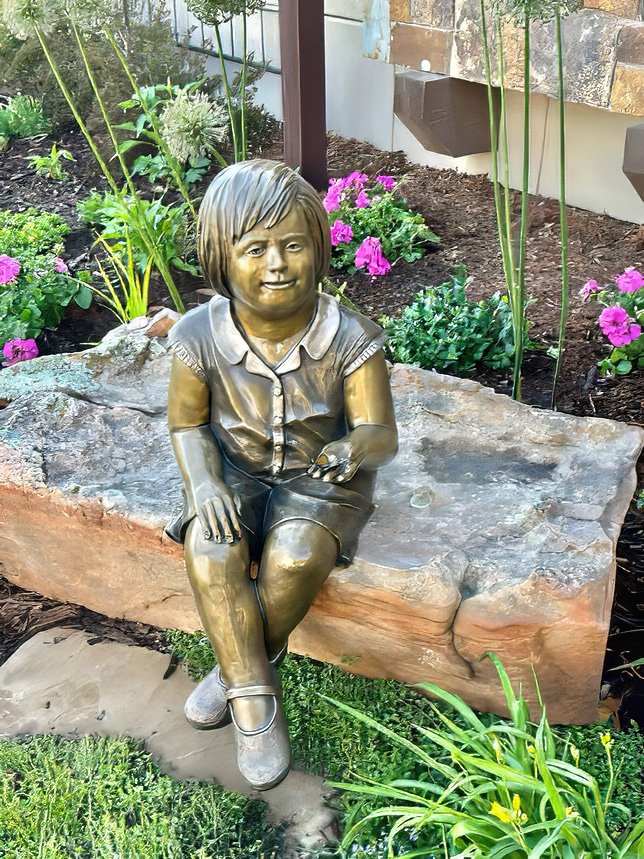
"Marilee", locally installed in 2023
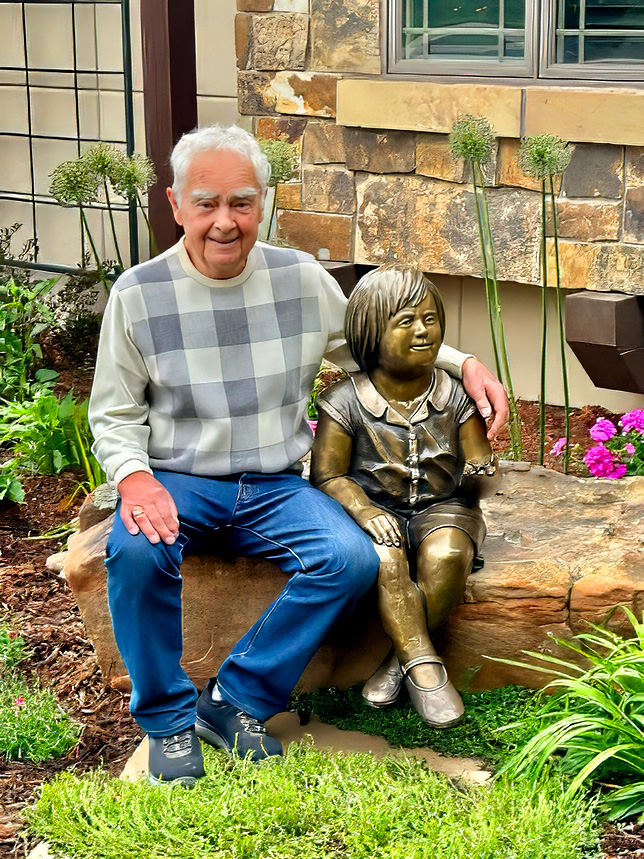
George and "Marilee"
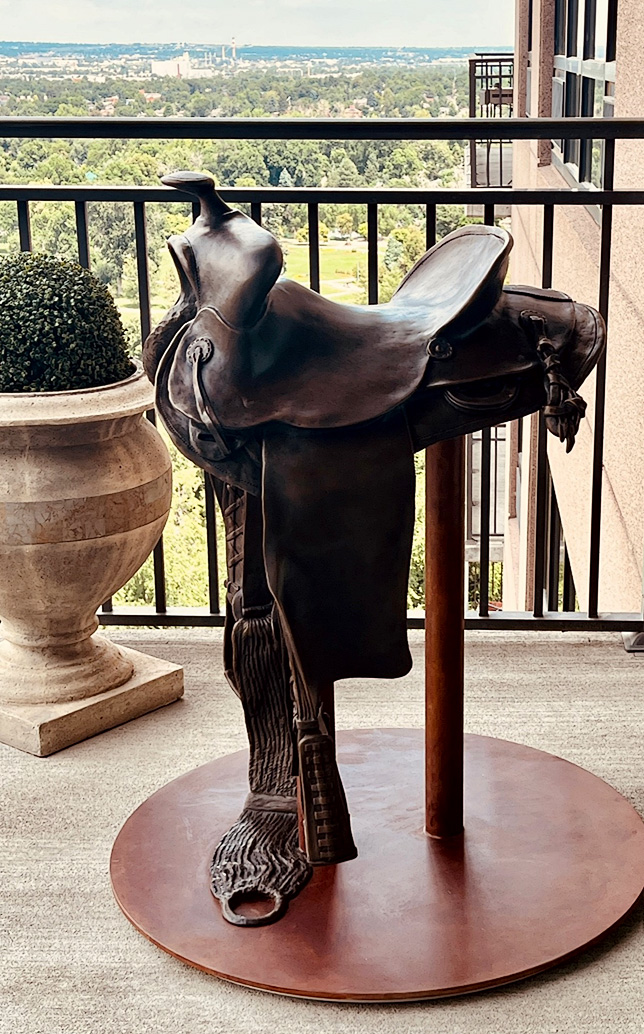
"Dr's Saddle", installed in Denver in 2023
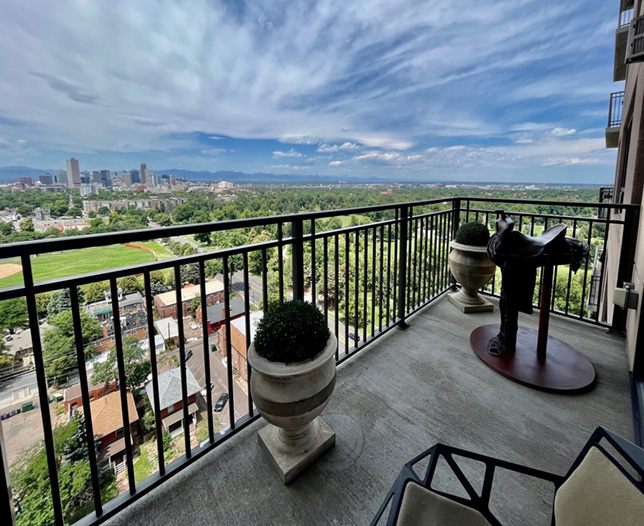
Toh-Atin Gallery
145 W. 9th Street, Durango, Colorado 81301
November 1, 2017
You can’t make this stuff up! A Trading Story with George Walbye!
In 1973, I was driving our company vehicle, a Dodge Maxi-Van, on a trip through Colorado to sell jewelry and rugs to some of the stores in the Estes Part and Denver areas. This was several years before we opened an actual gallery in Durango. We were doing business out of the front of my Dad’s Pepsi plant in Durango.
Anyway, I was driving through Loveland, Colorado and the van was making a weird noise. There was a Ford dealership on the road leading to I-25. I thought I’d pull in and see if they could look at it.
When I got out of the van at the Service area, a real nice guy named Art came up and asked me what he could do for me. I explained what the problem was and he said they would take a look at it. I opened the back door of the van to get my briefcase out so I could do some paperwork while I was waiting and Art saw all of the Navajo rugs in the back.
“Say,” he said, “you should meet George, one of the owners. He loves this kind of thing.” He then led me into the office where I met George Walbye. Now everything I knew about bronze sculptures would have fit in a thimble at the time, but the beautiful pieces he had around his office really caught my attention. It turns out that George was a real life honest to goodness cowboy at one time in his life and had grown up in Wyoming. He loved Western art and he also loved the Native American culture. Around the office, he had beadwork, pottery and a couple of Navajo rugs.
They don’t make people any nicer than George and he was very interested in seeing the weavings. We carried some into his office and he set his mind on a couple. “Do you want to trade for sculptures?” he asked.
Well, I didn’t know anything about bronzes, so, of course, I said sure! I had no idea what I’d do with them, but they were pretty neat. We worked out a trade and I ended up with three really neat sculptures. I had to leave as I had an appointment with a mortician in Boulder who wanted to buy rugs.
When I got to Boulder, it turned out that the mortician was a collector of Zuni fetish necklaces. He had his own airplane and flew to Zuni three or four times a year to buy necklaces from the artists.
He bought one rug and we traded another one for a beautiful fetish necklace. When he helped me carry the rugs to the van, he saw the sculptures in the back and asked me about them. I had only owned them for an hour, but I did know the values George had put on them, so I told him they were for sale. At the time, not a lot of people had heard of George Walbye. Today, he is a well known sculpture and a founder of the Art in the Park Sculpture Show, one of the most prestigious in the country. We took the bronzes in and they looked great in his house. He ended up paying me part cash and we traded part of the bill for fetish necklaces. I was wondering how I was going to explain what I had been doing to my father!
By now it was about 3 p.m. and I decided that maybe it would be a good thing to get more of George’s sculptures, so I drove back up to Loveland to see him. George and I just clicked. He had been thinking about a rug that he had passed on that morning. I told him that I had some fetish necklaces that he might like as well and explained that I had just traded his bronzes for them. He laughed and we ended up trading for two more sculptures. I still have one of them.
George and I have continued our friendship for 44 years. I visit him whenever I am in Loveland and we talk on the phone occasionally. He has done a couple of shows in our gallery, but focuses on the Art in the Park.
What I love about George is that he sculpts for pleasure, for his love of creating. Money isn’t that big a deal. He was a top notch tennis player and bike rider and, more than anything else, loves having fun.
Over the years, he also taught me a lot about the art of trading. I think he would rather trade than sell something. At one of the early shows we had, Ben Nighthorse was the other featured artist. They ended up trading. At another show, Navajo painter Mark Silversmith and he ended up trading. George has a great collection of art that he has traded for his work and I have never met anyone that felt George took advantage of them.
His theory on that is pretty common among quality dealers and artists.
“Every time I work with someone,” George explained, “it has to work for both people. That’s the most important part of any deal.”
Antonia and I were lucky to grow up in the business with a father that felt the same way. It’s a good rule to live by.
George Walbye is a special person that I am pleased to have known for all these years.
Thanks for following our newsletter!
Jackson Clark II
Toh-Atin Gallery •
Durango, CO •
www.toh-atin.com
